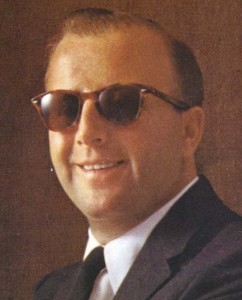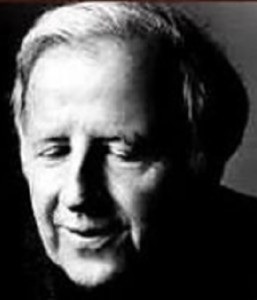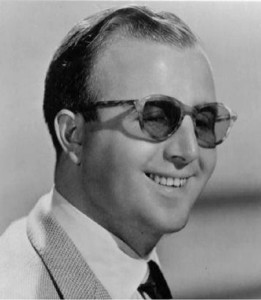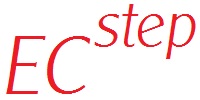George Shearing
–
One of the 20th century’s most gifted jazz pianists
–
Pianist George Shearing is that rare thing, a European jazz musician who became a household name in the US, as a result of the “Shearing sound”―the recordings of his historic late 1940s quintet.
Together with his unique “locked hands” approach to playing the piano, Shearing’s quintet with guitar and vibraphone in close harmony to his own playing revolutionized small group jazz and ensured that after seven years as Melody Maker’s top British pianist, he achieved even greater success in America.
His compositions have been recorded by everyone from Sarah Vaughan to Miles Davis, and his best-known pieces include “Lullaby of Birdland” and “Conception”.
His story is all the more remarkable because Shearing was born blind.
His candid reminiscences include a behind-the-scenes experience of New York’s 52nd Street in its heyday, as well as memories of a vast roll-call of professional colleagues that includes all the great names in jazz.
◊
Sir George Albert Shearing, OBE (Order of the British Empire) (13 August 1919 – 14 February 2011) was a jazz pianist who for many years led a popular jazz group that recorded for Discovery Records, MGM Records, and Capitol Records.
He was the composer of over 300 titles, including the jazz standards “Lullaby of Birdland” and “Conception”, and had multiple albums on the Billboard charts during the 1950s, 1960s, 1980s, and 1990s.
He died of heart failure in New York City, at the age of 91.
Early life
George Shearing was born in Battersea, London, being the youngest of nine children.
He was born to working-class parents: his father delivered coal and his mother cleaned trains in the evening having cared for her children during the day.
Blind from birth, George showed musical aptitude, memorizing tunes he had heard on the radio and picking them out on the family’s piano, taking lessons from a local teacher at the age of three and then continuing his studies for four years at the Linden Lodge School for blind children in Wandsworth.
 Offered university musical scholarships, he turned them down in favor of paid work – “25 bobs a week” – as a solo pianist in local pubs, starting when 16 at the Mason’s Arms, Battersea, and concentrating first on popular songs and then branching out into jazz.
Offered university musical scholarships, he turned them down in favor of paid work – “25 bobs a week” – as a solo pianist in local pubs, starting when 16 at the Mason’s Arms, Battersea, and concentrating first on popular songs and then branching out into jazz.
He achieved a degree of prominence with Claude Bampton’s newly formed, all-blind stage orchestra in 1937, joining as the second pianist: press coverage of the time described this as “a phenomenal venture”.
A fellow band member, the partially sighted drummer Carlo Krahmer, encouraged Shearing’s jazz interests.
“I’d spend hours and hours at Carlo’s house and he’d play things that introduced me to the styles of many great players,” he recalled. 
Spurred on by access to Krahmer’s record collection, Shearing formulated an approach heavily influenced by Teddy Wilson and Fats Waller, plunging into the London after-hours club scene and sometimes playing alongside visiting American stars such as the tenor-saxophonist Coleman Hawkins, while enjoying Waller at first hand.
He made his first solo radio broadcast in 1938 and began to record regularly, either as a soloist or with groups led by Vic Lewis and the top players of the day. In 1941 he met and married Trixie Bayes.
With what now appears to be dazzling speed, he moved through bands and small groups fronted by prominent leaders including the clarinetist Harry Parry, Bert Ambrose, Harry Hayes, and the French jazz violinist Stéphane Grappelli, with whom he recorded frequently, Grappelli being at that point resident in London as a refugee from German-occupied Paris.
◊ ◊ ◊
George Shearing – On Stage (Full Album)
Piano: George Shearing, Bass: Al McKibbon, Drums: Percy Brice, Guitar, Harmonica: Jean Toots Thielemans, Percussion: Armando Perazo, Vibraphone: Emil Richards.
Recorded – 1957 – Claremont College in Southern California.
00:00 September In The Rain
03:32 Introductions
04:00 On The Street Where You Live
04:48 Roses Of Picardy
07:45 Little Niles
15:15 Caravan
20:09 I’ll Remember April
23:23 Little White Lies
28:54 East Of The Sun
31:52 Nothing But De Best
◊ ◊ ◊
So complete was Shearing’s mastery of jazz piano that the Melody Maker poll voted him the top British pianist for seven years in a row.
Aware of being the proverbial big fish in a rather small local pond, Shearing accepted an invitation from the British writer Leonard Feather, a friend from London who had already emigrated, to visit New York in late 1946.
He stayed for three months and recorded a trio date for the Savoy label.
United States years
Encouraged by this experience and enthralled by what he had heard, Shearing moved for good in December 1947.
 By now heavily into bebop, he began to attract attention as the intermission pianist at the Hickory House on 52nd Street, sometimes acting as Ella Fitzgerald’s accompanist on her pianist’s night off before finally landing a quartet engagement at the Clique Club with the fine clarinetist Buddy De Franco.
By now heavily into bebop, he began to attract attention as the intermission pianist at the Hickory House on 52nd Street, sometimes acting as Ella Fitzgerald’s accompanist on her pianist’s night off before finally landing a quartet engagement at the Clique Club with the fine clarinetist Buddy De Franco.
Set to record, De Franco had to drop out for contractual reasons and Feather came to the rescue, suggesting that Shearing might try a quintet instead, adding guitar and vibraphone to the usual piano, bass, and drums trio.
Voiced in block chords with Shearing using the “locked-hands” style pioneered by the pianist Milt Buckner, where the melody is harmonized in the right hand and echoed in the left, the quintet’s new approach caught on immediately, their recording of September in the Rain, made in February 1949, selling 900,000 copies.
Where bebop had seemed over-complex to many listeners, here was a musical style that sounded modern and new, but was easy to enjoy.
By now one of the hottest tickets in jazz, Shearing’s quintet toured endlessly, recorded incessantly and played residencies at the best clubs in every major American city.
◊ ◊ ◊
The George Shearing Quintet – Latin Escapade (1956)
Perfidia – 0:01 | Mambo With Me – 3:27 | Without You – 5:50 | Old Devil Moon – 8:42 | Mi Musica Es Parati – 12:13 | Anitra’s Nañigo – 14:54 | Yours – 16:40 | Cuban Love Song – 19:48 | Watch Your Step – 22:38 | Poodle Mambo – 25:27 | Canto Karabali (Jungle Drums) – 28:18 | Strange Enchantment – 30:37
◊ ◊ ◊
Credited with some 300 compositions of his own, Shearing gained his greatest success with Lullaby of Birdland (1952), commissioned as the theme music for a radio program based around the famous Birdland club in New York.
“I always tell people it took me 10 minutes and 35 years in the business,” he said, adding that the other “299 compositions enjoyed a bumpy ride from obscurity to oblivion.”
Gradually, Shearing began to introduce a classical element to his concerts, sometimes performing as a soloist with orchestras, and with the quintet featured for the rest of the concert.
He also formed a big band, appeared in the film Jazz on a Summer’s Day (1959), and recorded with Latin ensembles, adding a conga player to the quintet. Beauty and the Beat (also 1959), his album with the singer Peggy Lee, was another runaway success.
Shearing’s interest in classical music resulted in some performances with concert orchestras in the 1950s and 1960s, and his solos frequently drew upon the music of Satie, Delius, and Debussy for inspiration.
He became known for a piano technique known as “The Shearing Sound”, a type of double melody block chord, with an additional fifth part that doubles the melody an octave lower.
With the piano playing these five voices, Shearing would double the top voice with the vibraphone and the bottom voice with the guitar to create his signature sound.
(This piano technique is also known as “locked hands” and the jazz organist Milt Buckner is generally credited with inventing it.)
In 1956, Shearing became a naturalized citizen of the United States.
By 1968, Shearing’s nimble, witty jazz style was showcased in smaller lineups, with trios giving way to duos, this pared-down format allowing him a free rein to move from Bach to bebop in a single number.
He continued to play with his quintet, with augmented players through the years and recorded with Capitol until 1969.
He created his own label, Sheba, that lasted a few years. Along with dozens of musical stars of his day, Shearing appeared on ABC’s The Pat Boone Chevy Showroom.
Earlier, he had appeared on the same network’s reality show, The Comeback Story, in which he discussed how to cope with blindness.
Since then, he became one of the country’s most popular performing and recording artists.
In 1982 and 1983 he won Grammy Awards with recordings he made with Mel Torme.
Later career and celebration
In 1970, he began to “phase out his by-now-predictable quintet” and disbanded the group in 1978.
One of his more notable albums during this period was The Reunion, with George Shearing (Verve 1976), made in collaboration with bassist Andy Simpkins and drummer Rusty Jones, and featuring Stéphane Grappelli, the musician with whom he had debuted as a sideman decades before.
Later, Shearing played in a trio, as a soloist, and increasingly in a duo.
Among his collaborations were sets with the Montgomery Brothers, Marian McPartland, Brian Q. Torff, Jim Hall, Hank Jones, Niels-Henning Ørsted Pedersen, and Kenny Davern.
In 1979, Shearing signed with Concord Records and recorded for the label with Mel Tormé.
This collaboration garnered Shearing and Tormé two Grammys, one in 1983 and another in 1984.
Shearing remained fit and active well into his later years and continued to perform, even after being honored with an Ivor Novello Lifetime Achievement Award in 1993.
He returned regularly to Britain, once with the ex-Count Basie singer Joe Williams, another time with the vocalist Carmen McRae and latterly in a duo with the bassist Neil Swainson, appearing with Tormé and the BBC Big Band for a special 80th birthday show in 1999.
Mr. Shearing was the subject of an hour-long television documentary entitled “The Shearing Touch” presented on the Southbank Show with Melvyn Bragg on ITV in the UK.
Three presidents have invited Mr. Shearing to play at the White House… Ford, Carter, and Reagan.
He performed at the Royal Command Performance for Queen Elizabeth II and Prince Philip.
He is a member of the Friars Club and the Lotos Club in New York and the Bohemian Club in San Francisco.
His awards and honors are many. In May 1975, he received an honorary degree of Doctor of Music from Westminster College in Salt Lake City.
In May of 1994, Hamilton College in upstate New York awarded him another honorary doctorate in music.
DePauw University in Greencastle, Indiana presented him with an honorary doctorate of music on June 1, 2002.
He received the prestigious Horatio Alger Award for Distinguished Americans in 1978 and a community recreational facility in Battersea, south London, was named the George Shearing Centre in his honor.
In May of 1993, he was presented with the British equivalent of the Grammy…the Ivor Novello Award for Lifetime Achievement.
He never forgot his native country and, in his last years, would split his year between living in New York and Chipping Campden, Gloucestershire, where he bought a house with his second wife, singer Ellie Geffert.
In June of 1996, Mr. Shearing was included in the Queen’s Birthday Honors List and on November 26, 1996, he was invested by Queen Elizabeth II at Buckingham Palace as an Officer of the Order of the British Empire (OBE) for his “service to music and Anglo-US relations.”
He was presented the first American Music Award by the National Arts Club, New York City, in March of 1998.
In 1999, his 80th birthday was celebrated in England where he played to a sold-out house at the Birmingham Symphony Hall.
Also appearing with him were the BBC Big Band, the strings of the London Symphony, Dame Cleo Laine, and John Dankworth.
BBC Radio 2 presented a 2 1/2-hour “Salute to Shearing” in honor of his birthday.
The following year another sold-out house at Carnegie Hall was treated to his birthday celebration featuring the George Shearing Quintet with Nancy Wilson, Dave Brubeck, Dr. Billy Taylor, the John Pizzarelli Trio, Tito Puente, and Peter Schickele who brought a special greeting from PDQ Bach!
Mr. Shearing’s biography, “Lullaby of Birdland,” published by Continuum, was released in February 2005.
In conjunction with the autobiography release, Concord Records released a composite of Shearing recordings in a 2-CD set entitled “Lullabies of Birdland.: A Musical Autobiography” which was immediately followed up with “Hopeless Romantics” with Michael Feinstein.
Shortly afterward, however, he suffered a fall at his home and retired from regular performing.
Concord then released the collectors set Mel Tormé & George Shearing: The Concord Years.
Mr. Shearing’s popularity continued to rise.
In November 2006, a letter arrived from the Prime Minister’s office in London reading, in part, “The Prime Minister has asked me to inform you, in strict confidence, that …….he has it in mind, on the occasion of the forthcoming list of New Year Honours, to submit your name to The Queen with a recommendation that Her Majesty may be graciously pleased to approve that the honor of Knighthood be conferred upon you.”
When the letter was read to him, George simply said, “I don’t know why I’m getting this honor…..I’ve just been doing what I love to do.”
And, when asked by the press how he felt about receiving the highest honor the Queen can give, he replied, “My mind keeps flashing back on my beginnings as a pianist playing in a pub for the equivalent of $5.00 a week.
What a journey it has been from that pub to Buckingham Palace. Receiving such an honor as a Knighthood might also show young people what can be achieved in life if one learns his craft and follows his dreams.”
So, the poor, blind kid from Battersea named George Shearing, the youngest of nine, whose father once delivered coal to the Palace, with four years of formal musical training but with a tremendous will to make good, traveled with his wife, Ellie, to London to claim his honor.
On June 13, 2007, George was presented to Queen Elizabeth II in the Ballroom of Buckingham Palace.
The Queen first touched him on each shoulder with the sword her father had used, then stepped down off the dais to put the medal around his neck, adjusted it, shook hands with him, and talked to him for several minutes.
He became Sir George Shearing “for his contribution to music”, as the Lord Chamberlain put it. Now, that’s a fairy tale come true!
After the ceremony, Sir George and Lady Shearing hosted a luncheon for some of their closest friends including Dame Cleo Laine and Sir John Dankworth, the BBC personality and interviewer, Michael Parkinson (who championed George’s receiving a Knighthood on his radio and television shows), and the actress Julia McKenzie.
The following week, Sir George’s relatives came to lunch….. including his 97-year-old sister, Dolly. She was the life of the party….leading the Sing-Song between courses of the meal! And the celebrations didn’t stop there.
The Shearings hosted a tea for the member of Parliament and former Home Secretary, David Blunkett, along with the Dean of Canterbury, The Very Reverend Robert Willis. Mr. Blunkett was also born blind and lived for ten years right next door to the Linden Lodge for the Blind.
And, the honors kept coming! Back in New York, on October 21, 2007, the Town Hall Foundation presented Sir George with its Annual Friend of the Arts Award “in recognition and appreciation of his abiding interest in the development, enrichment, and support of the arts”.
With this award also came a metal plaque, bearing Sir George’s name, being placed on the back of one of the seats in the legendary Town Hall.
In 2012 Derek Paravicini and jazz vocalist Frank Holder did a tribute concert to the recordings of Shearing.
Ann Odell transcribed the recordings and taught Paravicini the parts, as well as being the MD for the concerts. Lady Shearing also endorsed the show, sending a letter to be read out before the Watermill Jazz Club performance.
But, on July 1 every year, one could find the Shearings traveling from their New York City apartment up to the beautiful Berkshires near Tanglewood where, for the entire summer, they would attend concerts by the Boston Symphony, entertain their many friends (both in and out of the music profession), and, yes, listen to the crickets while sipping a glass of wine while simply enjoying life together.
George Shearing was a member of the Bohemian Club and often performed at the annual Bohemian Grove Encampments. He also composed music for two of the Grove Plays.
Lullaby of Birdland – Early Version
–
September in the rain
–
Conception
–
Pick Yourself Up
–
I’ll Remember April
–
The Shadow of Your Smile
–
East of the Sun – West of the Moon
–
I’ll Be Around
–
Move
–
Swedish pastry
–
Misty
–
So Rare
–
As I Love You
George Shearing (p), Emil Richards (vib), Toots Thielemans (g), Al McKibbon (b), Percy Brice (ds)
–
I Didn’t Know What Time It Was / Conception
–
George Shearing Quintet – Jazz Concert (Full Album)
01. Walkin’ 00:00
02. Love Is Just Around The Corner 08:00
03. I Cover The Waterfront 21:08
04. Love Walked In 28:13
05. There With You 34:38
06. Bel Aire 39:25
Recorded At – Santa Monica Civic Auditorium
Piano – George Shearing
Double Bass – Bill Yancey
Drums – Vernel Fournier
Guitar – John Gray
Vibraphone – Gary Burton
–
George Shearing Quintet – Live, 1953
Live from the Blue Note Jazz Club in Chicago in 1953, here is an NBC radio broadcast of the George Shearing Quintet. (Toots Thielemans, guitar/harmonica; Al McKibbon, double-bass; Cal Tjader, vibes; Bill Clark, drums; and George Shearing, piano.)
I. “Love Is Just Around the Corner” 00:55
II. “Over the Rainbow” 4:08
III. “Mood for Milt” 7:38
IV. “Easy Living” 18:05
V. “September in the Rain” 22:43
VI. “The Lady Is a Tramp” 25:37
–
The artistry of George Shearing
–
George Shearing plays My Funny Valentine. Recorded in 1956.
–
George Shearing – In Dixieland (Full Album)
George Shearing – piano
Kenny Davern – clarinet
Warren Vaché – cornet
Ken Peplowski – tenor saxophone
George Masso – trombone
Neil Swainson – double bass
Jerry Fuller – drums
………………………………………………………………
00:00 [01] Clap Yo’ Hands
03:54 [02] Mighty Like the Blues
06:39 [03] Truckin’
10:36 [04] Fascinating Rhythm
13:47 [05] Destination Moon
18:37 [06] New Orleans
22:05 [07] Soon
25:16 [08] Take Five
28:39 [09] Lullaby of Birdland
33:00 [10] Jazz Me Blues
36:37 [11] Blue Monk
43:38 [12] Desafinado
47:51 [13] Honeysuckle Rose
51:25 [14] Alice in Dixieland
Recorded – 1989
–
Conversation with George Shearing May 1985
Leigh Kamman has a conversation with the great pianist and composer George Shearing.
George talks about coming to America and sitting in at Minton’s during the birth of be-bop music.
Included is a priceless remembrance of his experience with Charlie Parker.
–
Remembering Sir George: At Home with Ellie Shearing
Interview with Ellie Shearing, widow of legendary jazz pianist, George Shearing.
Ms. Shearing looks back at her life with Sir George in this March 2014 interview conducted by Rich Vinette in the couple’s home in New York City.
–
References and links:
Lullaby of Birdland: The Autobiography of George Shearing
The Best Of George Shearing (1955-1960)
The Best Of George Shearing (1960-69) (Vol. 2)
Best Of George Shearing: His Original Capitol Recordings
The Young George Shearing – From The Archives (Digitally Remastered)
George Meets The Lion – The Original Quintet & The Solos
Ballad Essentials: George Shearing
Lullaby of Birdland: Blues Alley Jazz/On a Clear Day
Proper Introduction to George Shearing: Conception


